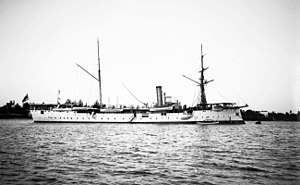Bussard-class cruiser

SMS Bussard in Dar es Salaam
|
|
| Class overview | |
|---|---|
| Preceded by: | Schwalbe class |
| Succeeded by: | SMS Gefion |
| Built: | 1888–1895 |
| Completed: | 6 |
| Lost: | 3 |
| Scrapped: | 3 |
| General characteristics | |
| Type: | Unprotected cruiser |
| Displacement: | 1,868 t (1,838 long tons) |
| Length: | 82.60 m (271 ft) |
| Beam: | 12.50 m (41 ft) |
| Draft: | 4.45 m (14 ft 7 in) |
| Propulsion: | 3-cylinder triple expansion engines, 2 screws |
| Speed: | 15.5 knots (28.7 km/h; 17.8 mph) |
| Range: | 2,990 nmi (5,540 km) at 9 knots (17 km/h; 10 mph) |
| Complement: |
|
| Armament: |
|
The Bussard class of unprotected cruisers were built for the German Kaiserliche Marine (Imperial Navy) in the late 1880s and early 1890s. The class comprised six ships: Bussard, the lead ship, Falke, Seeadler, Cormoran, Condor, and Geier. Designed for service in Germany's colonial empire, the class emphasized a long-range cruising radius and relatively heavy armament; they were also the last cruisers in the Kaiserliche Marine to be equipped with an auxiliary sailing rig. The ships were equipped with eight 10.5-centimeter (4.1 in) guns.
All six ships served abroad for the majority of their careers, primarily in Africa and the south Pacific, where they assissted in the suppression of uprisings such as the Boxer Rebellion in China and the Sokehs Rebellion in the Caroline Islands. Cormoran participated in the seizure of the Kiautschou Bay concession in China in 1897, and Falke was involved in the Venezuela Crisis of 1902–03. Bussard and Falke were broken up for scrap in 1912, but the remaining four ships were still in service following the outbreak of World War I in August 1914.
Cormoran was based in Tsingtao with unusable engines; she was scuttled in the harbor since she was no longer operational. Geier briefly operated against British shipping in the Pacific before having to put into Hawaii for internment by the then-neutral United States. After the United States entered the war in April 1917, she was seized and commissioned into the US Navy as USS Schurz; she served as an escort until she was accidentally sunk following a collision with a freighter in June 1918. Seeadler and Condor, meanwhile, had been converted into mine storage hulks after the start of the war. Seeadler was destroyed by an accidental explosion in 1917. Condor was the only member of the class to survive the war, and she was scrapped in 1921.
...
Wikipedia
